Rodless cylinders is a cylinder without a rod. It seems like a stupid idea because if there isn’t a rod, how does it do work?
I accidentally discovered the concept of a rodless cylinder a few years ago on the job, I didn’t know it was an actual thing then. We had a clamping system powered by two pneumatic cylinders. In the process of installing the machine, we were doing some grinding and the dust stuck to the aluminum cylinder without us knowing.
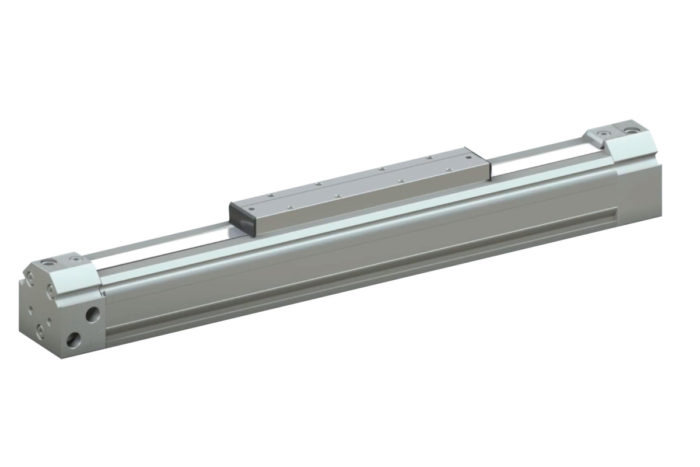
Once the system was ready, we stroked the cylinders and all of the dust collected into one spot. The spot where the piston was. We now were stroking the cylinder to watch the dust move with the cylinder. It was like we were kids in a candy shop again.
Apparently, the piston was magnetic and we couldn’t leave it alone; Challenge Accepted! We were finding steel plates and other magnets to see how much this could lift. It ended up being several pounds. We just made a rodless cylinder. (I later found out that most pneumatic cylinders have magnetic pistons so that the position of the rod can be monitored with a sensor.)
This concept also popped up as I was searching for ideas on how to make a launch on my roller coaster. Pneumatics can be a great method of propulsion and I stumbled upon the video below. This man built the largest rodless cylinder I have ever seen. In fact, it is a continuous loop!
A rodless cylinder is a cylinder with no rod. Output motion is achieved by attaching to piston either through direct connection or using magnets. The piston is moved through the cylinder by applying compressed air (or vacuum) at the ports. With no rod to extend, the cylinder is compact and doesn’t get larger.
So the first question you probably have is how do you attach to the piston without leaving a gaping hole in the side? Good question!
Magnetic Attach Rodless Cylinders
Let’s start with the easy version, magnetic coupling. As we found in the shop that day, you can design a cylinder with a magnetic piston and then attach things on the outside to ride along. With this design, it is easy to seal and there is no air leakage.
There are some limitations that we need to address. First, there is a limit to the forces and moments that can be applied to the cylinder. The internal magnets can only hold a finite load. If the load is exceeded, the outer magnets can slip off from a high shear load (sliding) or a high moment load (prying). To mitigate this, longer pistons can be used to give a wider stance for the prying loads.
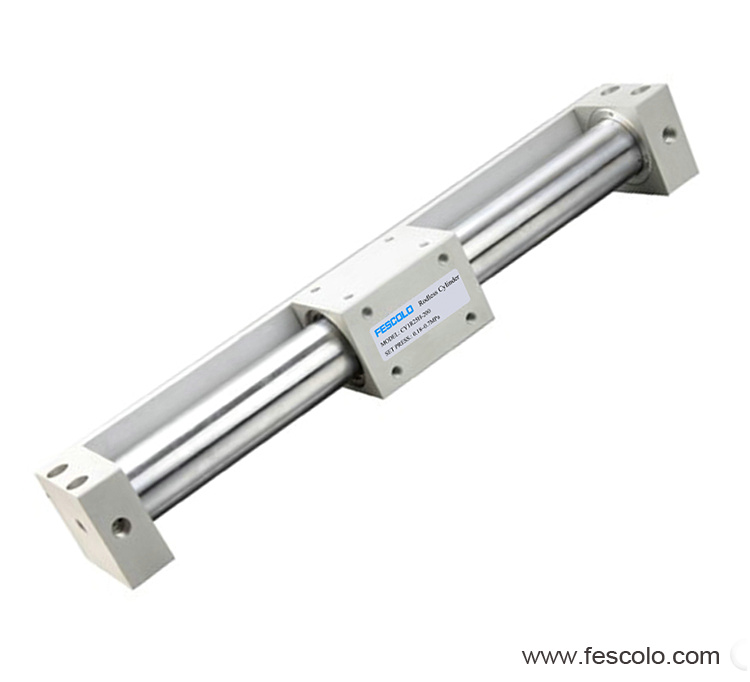
Image courtesy of Fescolo
Second, it is a bad idea to have hard steel plates or magnets running along the side of the cylinder tube. These tubes are usually aluminum and could wear out. If higher moment load is need, a guide rail system can be added for support.
On thing about magnets is that you loose force very quickly as the gap gets larger and larger. These instruments have close tolerances as a result and dust and dirt can cause sticking and binding. Magnets also have a tendency to find any ferrous material in the area. Generally speaking, you will want to use this in a relatively clean environment.
Despite these disadvantages magnetic rodless cylinders are strong and robust.
Direct Mount Rodless Cylinders
Directly mounting your apparatus to the piston is a trickier task. As shown below, there are a few more components involved. Using a flexible inner seal, air pressure can be maintained without leaking. An outer steel band is used to make sure that no one punctures a hole in the inner seal. A shuttle is also mounted to the piston for the purposes of easy mounting to your application.

Artwork by Stephen Schandel
8 Tips for Selecting a Rodless Cylinder
If you go to a resource like McMaster Carr (best website in the world) and buy a rodless cylinder, you will probably pick the wrong one at first. Don’t buy it until you read the rest of this article. You will probably find that you need a different one.
In order to select a rodless cylinder you need to: evaluate the air pressure, plan for size and stroke, calculate loads and moment in static and dynamic conditions, account for impact loading and friction and consider the operating environment
1. Get an Accurate Pressure Reading at the Location
I have been burned by this twice. The first time was because I didn’t notice that due to line distance, the pressure had dropped 8 psi between the compressor and the where I needed it. Now, my cylinder wasn’t able to move the load fast enough because there wasn’t as much force to overcome inertia.
After that, I made it a habit to check the pressure of the connection when I designed a pneumatic system. This leads me to the second time I was burned. This time, I went in early in the day when few people were working. The machine I was working on was at the far end of the shop and was going to require a fair amount of flow to complete the task. Knowing the pressure was good, we proceeded with the design, but when it came time to fire up the machine, it worked great from 6 am to 7am.
After 7 am, everyone else starting using air tools and there wasn’t enough flow on the line to power all of the demand. However, there was still plenty of capacity at the compressor. The problem was the size of the line coming off the compressor to power all of the tools. We mitigated this problem by running a parallel line that only serviced my machine.
2. Plan for the Required Stroke
All cylinders have “dead length” in them. This is the total length when retracted minus the stroke. This length is mostly taken up by the end caps, cushion and piston. A rodless cylinder will have a longer dead length than a traditional cylinder. Often, this can cause issues when trying to fit it in the design. The manufacturer should provide this information for you.
3. Calculate the Loads
Calculating the load on a regular cylinder can be difficult, but it is worse on a rodless cylinder. The reason for this is that a normal cylinder will have the majority of its load along the center-line. This means that there is little side loading on the rod, piston and seals.
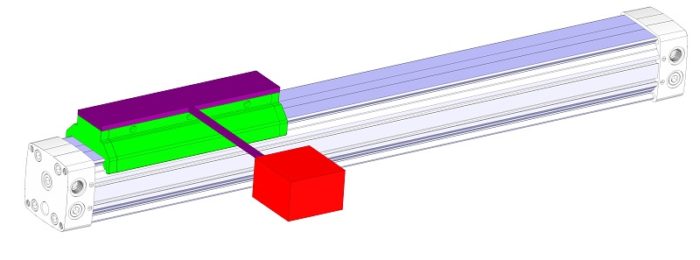
However, with a rodless cylinder, your load is going to be off center, which contributes a moment load to the cylinder. If I have a mass of 5 lb. that I am trying to raise at a distance of 10 inches from the cylinder center line, not only am I going to have to lift the 5 lb, but I am also going to need to support a moment of 50 in-lb. This can cause havoc on any cylinder.
4. Dynamic Loads
But it gets worse! We also need to calculate in the dynamic loads as well. Since we are dealing with compressible fluids, we can have rather large accelerations. In some cases, like reaching the end of the stroke, the load could be double. This would raise our 50 in-lb to 100 in-lb. If this isn’t planned for, your cylinder isn’t going to last very long.
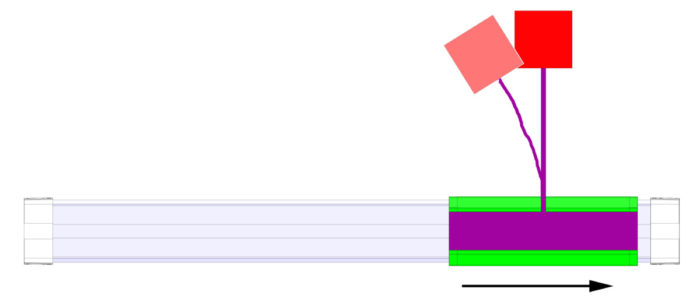
5. Size the Bore Properly
Once the loads have been calculated, we can calculate our bore size using the tried and true formula of force = pressure * area. Know our force and pressure as we can calculate the area and bore diameter. I usually add in an efficiency factor of 90% to 94% for cylinders. I would use the lower value of 90% for a rodless cylinder to accommodate not only friction, but also an increased breakaway force from side loading the cylinder.
6. Add Cushions or Shock Absorbers
Anyone who deals with pneumatics knows that it is difficult, if not impossible, to accurately control the position of a cylinder. It is for this reason that most cylinders are designed to either push up against something (clamping) or go full stroke.
If it is designed for full stroke, you will bang against the end of the cylinder. This is bad enough for a normal cylinder, but can be detrimental to a rodless cylinder. Most manufacturers would have you double the average velocity for the impact velocity. If your velocity was 12 inches per second, you would want to run your cylinder calculations for 24 in/s.
A good way to mitigate this problem is to add internal cushions to the design. Most manufacturers will have this option available (for additional cost of course). A cushion does exactly what it sounds like; it cushions the cylinder motion at the end of the stroke. It accomplishes this by cutting off flow as the cylinder reaches the end of the flow.
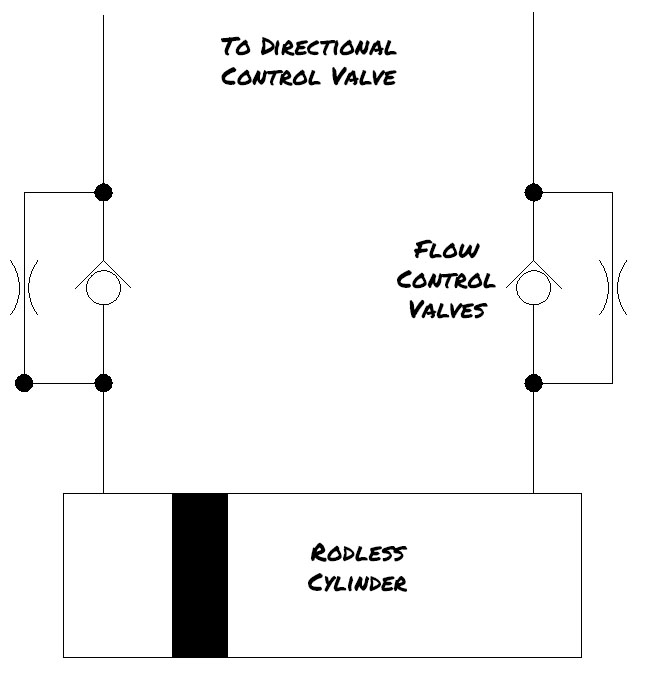
Pneumatic cylinders are best controlled by metering (restricting) the flow out of the cylinder and not into the cylinder. This is because a compressible fluid will tend to jump as it moves. If we meter out the flow, we keep the forces on both sides of the piston high. The high internal pressures will be much higher than the friction force. This results in much smoother travel when we meter fluid out.
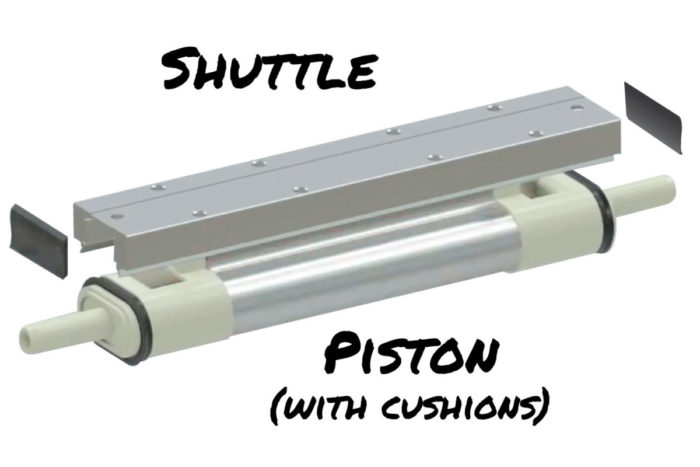
Cushions on pneumatic cylinders will restrict the outflow of air. This is done by the tube looking ends on the piston shown above. The tubes are slightly tapered and fit into a tapered hole in the cylinder end cap. The tapers will not touch, but as they move closer, it will restrict the flow of air causing the piston to slow down before the end of stroke it reached.
Shock Absorbers are another way of cushioning or perhaps adding extra cushion. Shock absorbers are readily available in a variety of shapes and sizes. Check out McMaster Carr to get started.
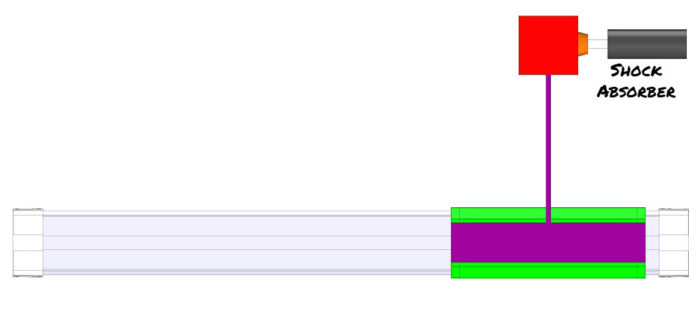
Even if your cylinder has a cushion, you may want to consider adding an external shock absorber to cushion the load. This will slow the load down preventing the transfer of moment to the cylinder. It also may allow you to reduce the size of cylinder.
7. Consider Orientation
Because of the cantilevered loads on a rodless cylinder, the installation orientation will effect performance. In a horizontal application, performance will be similar in both directions.
If we re-orient this to vertical direction, the cylinder will raise slower and fall very fast. This will include a much larger moment at the cylinder. This may not be desirable. When lowering a load, you may now need to lower the pressure, but also add a flow control valve to slow down motion.
8. Understand Operating Environment
With any mechanical component, we need to carefully consider the operating environment. As mentioned before, rodless cylinders generally need to be kept in a clean environment where dust and dirt aren’t prevalent. As a result, you will typically see these inside in industrial areas. Perhaps they are in a sealed unit with filtered air to keep contaminates out.
Other consideration may need to be made for high temperatures and corrosive chemicals (they deteriorate seals).
Having a good preventative maintenance routine is essential for a long life. It is recommended that these get weekly or even daily cleaning. Keeping the tracks clean will prevent premature wear.
Summary
Rodless cylinders are a wonderful invention. I believe that they are just in their infancy and will continue to be used in industrial applications more and more. With their compact size and high force, they are an excellent choice for motion.
Be sure to consider using a rodless cylinder the next time you design a machine.

